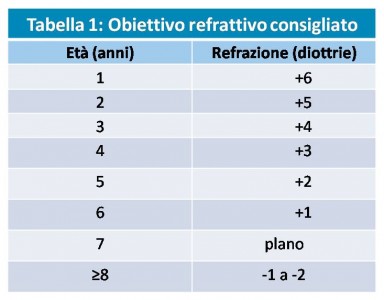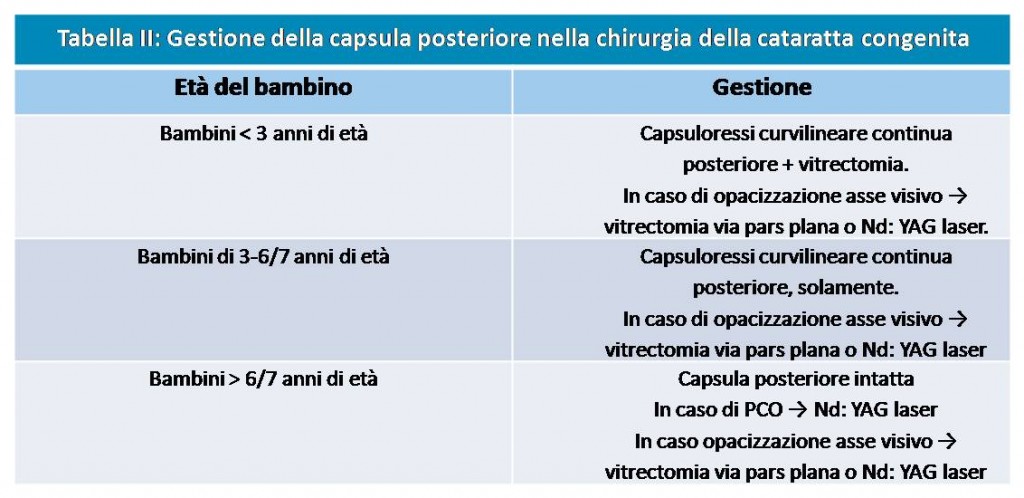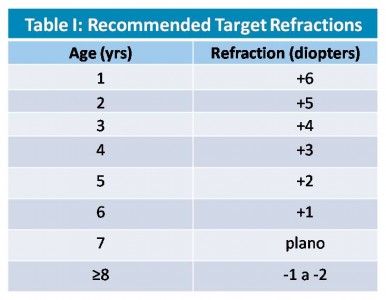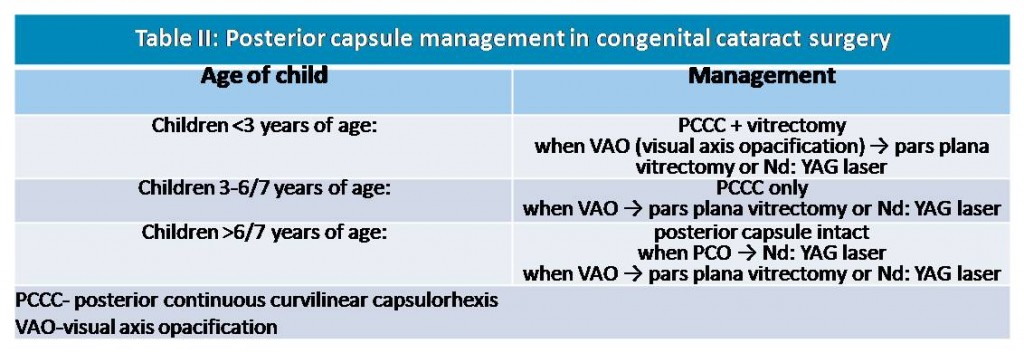Indications for cataract surgery in children
Congenital cataracts can cause visual impairment in children[1]. It is the cause of approximately 10% of cases of childhood blindness worldwide.[2]. In particular, a significant proportion of cases occur in developing countries[3,4].
Due to the rapid development of vision in the first 4 months of life (development of the fixation reflex), a lack or limitation of visual sensations due to an opaque lens leads in most cases to amblyopia, strabismus, nystagmus or even a secondary decrease of neurons in the lateral geniculate bodies and visual cortex (VDS - Visual Deprivation Syndrome).
The causes of congenital cataracts are innumerable; of particular note are genetic factors, intrauterine infections, the use of drugs during pregnancy and metabolic disorders in children[1]. Clinical management depends primarily on the nature and severity of the cataract. Amblyopia, intra- and post-operative difficulties, and frequent medical check-ups make the treatment of congenital cataracts a major challenge.
All these issues make cataract surgery in children technically more complex than in adults.
Indications for cataract surgery in children
The main indication for cataract removal is opacification of the crystalline lens, which prevents normal visual development.
When to operate on cataracts in children?
It is generally agreed that the greatest decrease in visual acuity occurs in the first few weeks of life. Up to 14 weeks of age, every three-week delay causes a decrease in visual acuity of one line in the Snellen tables. Between 14 and 31 weeks of age there is a further slight decrease in visual acuity. Cataract surgery performed by 4 weeks of age reduces the incidence of strabismus and nystagmus[5].
It is considered that unilateral cataracts should be operated before the sixth to eighth week, and bilateral cataracts before the tenth week of age[6,7]. Because of the risk of amblyopia, surgical treatment should be performed as early as possible. However, an increased incidence of secondary glaucoma is reported in the literature if surgical treatment is performed too early.[5,7,8].
Biometry and calculation of intraocular lens power
The significant growth of the eye in the early years of a child's life and the difficulties in predicting the final length of the eyeball are the main cause of problems in calculating the power of intraocular lenses. The refractive changes are the result of the increasing axial length of the eyeball, which varies from 16.8 mm in the infant to 22.6 mm in the adult, and the change in the curvature of the cornea (51.2 D in the infant; 43.5 D in the adult) and the lens (34.4 D in the infant; 18.8 D in the adult).
This makes most surgeons prefer to hypocorrect young children at the time of surgery (aiming for hypermetropic correction), in anticipation of significant myopic change over time. Enyedi et al proposed guidelines for identifying refractive targets at different ages based on their study data, as shown in Table I[9].
Based on the data of several studies, it has not emerged that one of the formulas used in the calculation of intraocular lens power is more effective. SRK II, SRK/T, Hoffer Q and Holladay are usually applied[10]. Dahan et al suggest leaving a 20% in under-two-year-olds and a 10% in 2-8-year-olds[11]. Lu et al reduce the power of implanting a 30% in children aged 6-12 months. After surgery, all children should be corrected with glasses or contact lenses.[12].
Choosing an intraocular lens (IOL)
The choice of IOL and the age of the child at the time of implantation are a matter of controversy.
It should be remembered that the younger the age of the patient at the time of IOL implantation, the greater the risk of re-intervention due to complications[13]. Artificial intraocular lenses are usually implanted in children older than 2 years (in the first year of life the refraction changes by about 10 D).
In the currently available literature, the minimum age of surgical patients for IOL implantation is 7 days[14]. LU et al claim that intraocular lens implants are safe in children between 6 and 12 months of age[12].
The most widely used site for IOL implantation is the capsular bag. It ensures the sequestration of the IOL from vascularised tissue. Fixation of the IOL in the ciliary groove creates more problems, as the lens comes into contact with the choroid. Some paediatric ophthalmologists claim that inserting the intraocular lens into the sac for aphakic eyes is ideal, but it is a very difficult technique[15].
Previous observations have shown very good results with hydrophilic acrylic lens implantation[3,16]. The AAPOS (American Association for Paediatric Ophthalmology and Strabismus) recommends the one-piece AcrySoft lens for implantation in children. It is easy to implant and is safe even in infants and children with macrophthalmia. Hydrophobic acrylic lens implantation is associated with a lower risk of posterior capsule opacification and secondary glaucoma[3]. Calcium and phosphate deposits were observed on the surface of hydrophilic acrylic lenses in a short period after surgical treatment[17,18]. Silicone lenses also accelerate the development of calcium deposits and are often associated with a higher risk of posterior capsular phimosis.[19]. Multifocal lenses are not recommended for implantation in children, as they require precise biometry and perfect centration, which may change during the healing period, due to possible fibrosis and growth of the eye. In recent years, a number of studies have been published in which authors describe the use of iris-supported IOLs in children. Sminia et al. implanted the Artisan lens in 10 children with an average age of 7.4 years in the years 1991-1999. The mean corneal endothelial cell density (ECD) was 2,702 cells/mm² 12 years after surgical treatment, and was comparable to the mean normal ECD for that age group, as reported in the literature[20].
Difficulties with cataract surgery in children
Cataract surgery in children is technically more complex than in adults. This is due to the anatomy of the child's eye. The crystalline lens is small, the anterior chamber is shallow, the anterior capsule is very elastic and thick, the posterior capsule is 3-5 times thinner and less elastic than in adults. In addition, low scleral rigidity makes self-sealing incisions difficult. Difficulties in mydriasis often require the use of iris retractors. During surgical treatment, increased vitreal pressure is often observed, usually as a result of scleral subsidence, which leads to a reduction in anterior chamber depth and iris prolapse. Due to the increased vitreal pressure, the IOL tends to 'distort' out of the capsular bag, instead of staying lodged within it.
In addition, postoperative complications, both early and late, occur more frequently than in adults. Very intense inflammatory reactions, fibrosis and rapid opacification of the posterior capsule require special intra- and postoperative management.
Surgical technique
The most common surgical issues in paediatric cataract surgery are the management of the anterior and posterior capsule, and the performance of anterior vitrectomy. Surgical access is usually through the cornea or the pars plana. The average amplitude in pars plana varies from 1.5 - 2 mm in infants, to 3 mm at 6 months of age.
Manual anterior curvilinear continuous capsulorhexis, with as smooth a margin as possible, is the gold standard for a successful outcome in paediatric cataract surgery. It is the preferred choice of surgeons for patients two years of age or older. Vitrectomy is preferred by surgeons during the first two years of life. Anterior capsulotomy can be performed using radiofrequency endodiathermy, but the final size will be larger.
Posterior capsule opacification (PCO) is the result of proliferation, migration and metaplasia of epithelial cells from the equatorial region of the anterior capsule to the posterior capsule. When the posterior capsule is left intact during surgery, the incidence of PCO is 100%. The onset of PCO generally increases 18 months after surgery. Therefore, in children under 8 years of age, posterior capsulotomy should be performed with an additional anterior vitrectomy[21]. Wilson leaves the posterior capsule intact in children over 6 years of age. In young children he performs a posterior capsulotomy via pars plana: in infants at 0.5 mm posterior to the limbus, under one year of age at - 2 mm posterior to the limbus, under 4 years of age at - 2.5 mm posterior to the limbus[3].
When the vitreous body is cut from the back, there is a lower risk of retinal detachment and cystoid macular oedema.
The management of the posterior capsule in children with congenital cataract, recommended by Vasavada, is outlined in Table II[24].
Complications after surgery
The most common complication after congenital cataract surgery is secondary glaucoma. Its prevalence is 15.4 - 19.5% within 10 years after surgery.[1,2]. Regular medical check-ups for many years after surgery are therefore very important.
An age of less than 9 months at the time of surgery and a micro-cornea predispose to the development of secondary glaucoma[2]. In children operated on before the age of 9 months, glaucoma occurs 3.8 times more often than in children operated on after this age.[2,23]. PHPV (Persistent Hyperplastic Primary Vitreous), a primary posterior capsulotomy or vitrectomy does not predispose to the development of secondary glaucoma[2]. In patients with glaucoma, bilateral cataracts were slightly more frequent than unilateral lens opacities[2]. The average time interval for the onset of glaucoma after surgery for a congenital cataract ranged from a few weeks to many years[2,8,23].
Retinal detachment has rarely been reported in children following congenital cataract surgery[13]. The least common postoperative complication is fibrinous uveitis.[4].
In the literature one can read reports of increased myopia in children, especially in the first two years after surgery[12,14].
In summary
Success in the treatment of congenital cataract depends first and foremost on an early diagnosis of the disease. Successful treatment is linked to the choice of the optimal surgical time, early visual rehabilitation and good cooperation with the parents. Achieving all these conditions makes it possible to ensure adequate visual acuity, on which visual function in adulthood will depend.
Alina Bakunowicz-?azarczyk, Beata Urban, Anna Bryl
Department of Pediatric Ophthalmology MU in Bialystok, Poland
For any questions - e-mail: alina.lazarczyk@umb.edu.pl
CONTROVERSIES IN PAEDIATRIC CATARACT MANAGEMENT
(original text in English)
Congenital cataract may cause visual impairment in children[1]. It constitutes approximately 10% of blindness cases among children, globally[2]. In particular, a large proportion of cases occurs in developing countries[3,4]. Due to the rapid development of vision in the first 4 months of life (developing fixation reflex), lack or limitation of visual sensations by the cloudy lens most often results in amblyopia, strabismus, nystagmus or even a secondary reduction of neurons in the lateral geniculate bodies and visual cortex (VDS - Visual Deprivation Syndrome).
There are many causes of congenital cataract; genetic factors, intrauterine infections, drugs used during pregnancy and metabolic disorders in children are specially emphasised[1]. The procedure primarily depends on the nature and severity of the cataract. Amblyopia, intra- and postoperative difficulties, frequent medical visits make that treatment of congenital cataract a challenge. All these dilemmas make cataract surgery in children technically more difficult than in adults.
Indications forcataract surgery in children
The main indication for cataract removal is cloudiness in the lens preventing normal visual development.
When to operate cataract in children?
It is believed that the greatest decrease in visual acuity falls on the first weeks of life. Up to 14 weeks of age, every three weeks delay in treatment causes a decrease in visual acuity of one line on the Snellen chart. Between 14 and 31 weeks of age is a further slight decrease in visual acuity. Cataract surgery at 4 weeks of age reduces the incidence of strabismus and nystagmus[5]. It is believed that the unilateral cataracts should be operated before the 6-8th week, and bilateral cataract before the 10th week of age[6,7]. Due to the risk of amblyopia, surgery should be performed as soon as possible. However, in the available literature a higher incidence of secondary glaucoma is described, if the treatment is carried out too early.[5,7,8].
Biometry and intraocular lens power calculation
The significant growth of the eye in the first years of a child's life and difficulties in predicting the final length of the eyeball, are the main cause of problems with the intraocular lens power calculation. Refractive changes are the result of increasing axial length of the eyeball, which varies from 16.8 mm in newborn to 22.6 mm in adult and a change in curvature of the cornea (51.2 D in newborn; 43.5 D in adults) and the lens (34.4 D in newborn; 18.8 D in adults).
It makes most surgeons prefer undercorrecting young children at the time of surgery (targeting for a hyperopic correction) in anticipation of a significant myopia shift over time. Enyedi et al presented guidelines for target refractions for various ages based on the results of their study. They are shown in Table I[9].
Many studies have not shown greater efficacy of one of the formulas used in the calculation of intraocular lenses in children. SRK II, SRK/T, Hoffer Q and Holladay are usually used [10]. Dahan et al suggest leaving in children under two years of age 20% hypocorrection and 10% in children aged 2-8 years[11]. Lu et al reduce the power of the implant by 30% in children aged 6-12 months. After surgery, all children should be corrected with glasses or contact lenses[12].
Choosingan intraocular lens (IOL)
IOL selection and age of child during IOL implantation are controversial. It must be remembered, that the younger age of the patient with implanted lens, the higher risk of reoperation due to complications[13]. Artificial intraocular lenses used to be implanted in children over 2 years (in the first year of life refraction changes are about 10 D). In the available literature, the minimum age for surgical patients with an intraocular lens is seven days.[14]. LU et al suggest, that intraocular lens implants are safe in children between 6 and 12 months of age[12]. The most popular site for IOL implantation is capsular bag. It provides IOL sequestration of vascularized tissue. Ciliary sulcus fixation of IOL is worse, because lens is in contact with the choroid. Some paediatric ophthalmologists recognise that In-the-bag intraocular lens placement for aphakic eyes is ideal, but it is very difficult technique.[15].
In previous observations very good results are obtained when the hydrophobic acrylic lenses were implanted[3,16]. AAPOS (American Association for Paediatric Ophthalmology and Strabismus) recommends Single-piece AcrySof lens to implant in children. It is easy to implant and it is safe even in infants and in children with microphthalmia. Hydrophobic acrylic lens implantation is also associated with a lower risk of posterior capsule opacification and secondary glaucoma.[3]. On the hydrophilic acrylic lens surfaces deposits of calcium and phosphate in a short period after surgery were observed.[17,18]. The silicone lenses also accelerate the development of calcium deposits and are often associated with higher risk of posterior capsular phimosis.[19]. Multifocal lenses due to the necessity of precise biometrics and perfect centration, which may change during healing, fibrosis and growth of the eye, are not recommended for implantation in children. In recent years, there are the publications, in which the authors described the use of iris claw IOLs in children. Sminia et al implanted Artisan lens in 10 children with mean age 7.4 years in years 1991-1999. Mean corneal endothelial cell density (ECD) was 2702 cells/mm² 12 years after surgery, and was comparable to the mean normal ECD for this age group reported in the literature.[20].
Difficulties during cataract surgery in children
Cataract surgery in children is technically more difficult than in adults. This is due to the anatomy of the child eye. The lens is small, anterior chamber is shallow, anterior capsule is very elastic and thick, posterior capsule is 3-5 times thinner and less elastic than in adults. In addition, low scleral rigidity makes it hard to get self-sealing incision. Difficulties with mydriasis often require the use of iris retractors. During surgery an increased vitreous pressure is often observed, usually as a result of scleral subsidence, resulting in shallowing of the anterior chamber and iris prolapse. Due to rising vitreous pressure, IOL tends to 'twisting' from the capsular bag, instead of being placed inside it. In addition, early and late postoperative complications occur more frequently than in adults. Very strong inflammatory reactions, fibrosis and quickly posterior capsule opacification require special intra- and postoperative management.
Surgical technique
The most frequent operational dilemmas in paediatric cataract surgery are: the management with anterior and posterior capsule, and performing of anterior vitrectomy. Operating access is generally through the cornea or the pars plana. Average pars plana width range from 1.5-2 mm in the newborn, to 3 mm at 6 months of age. Manual anterior continuous curvilinear capsulorhexis (ACCC) with the most regular edge is gold standard for the successful outcome of paediatric cataract surgery. It is preferred by surgeons for patients aged 2 years and older. Vitrectorhexis is preferred by surgeons during the first 2 years of life. Anterior capsulotomy can be done using radiofrequency endodiathermy, but the final size will be larger. Posterior capsule opacification (PCO) is the result of proliferation, migration and metaplasis of epithelial cells deriving from the equator region of the anterior capsule to the posterior capsule. When the posterior capsule is left intact during surgery, the incidence PCO is 100%,. Occurrence of PCO usually increases 18 months after surgery. Therefore, in children younger than 8 years posterior capsulotomy should be performed with an additional anterior vitrectomy.[21]. Wilson leaves posterior capsule intact in children over 6 years of age. In small children he performs posterior capsulotomy through the pars plana: in infants 0,5 mm posterior to the limbus, under 1 year - 2 mm posterior to the limbus, under 4 year - 2,5 mm posterior to the limbus and in children over 4 years of age - 3 mm posterior to the limbus.[3]. When the vitreous body is cut from the back, it is associated with a lower risk of retinal detachment and cystoid macular oedema. Posterior capsule management in children with congenital cataract, recommended by Vasavada, is shown in Table II[22].

Complications after surgery
The most common complication described after congenital cataract surgery is secondary glaucoma. Its prevalence is determined on 15.4 -19.5% within 10 years after surgery.[1,2]. Therefore, regular medical examinations for many years after surgery are very important. Age less than nine months at the time of surgery and microcornea predispose to development of secondary glaucoma[2]. In children operated before 9 months of age, glaucoma occurs 3.8 times more often than in children operated after this period of life[2,23]. PHPV, primary posterior capsulotomy or anterior vitrectomy does not predispose to development of secondary glaucoma[2]. In patients with glaucoma, bilateral cataract was slightly more common than unilateral lens opacities.[2]. The mean time to glaucoma after congenital cataract surgery was ranged from weeks to many years[2,8,23].Retinal detachment in children after congenital cataract surgery has been reported rarely[13]. The less common post-operative complication is fibrinous uveitis[4].
In the available literature reports of increasing myopia in children can be found, especially in the first 2 years after surgery[12,14].
Summary
Success in the treatment of congenital cataract primarily depends on early diagnosis of the disease. The success affects the optimal surgery time, early visual rehabilitation and good cooperation with parents. Fulfilling all these criteria determines a useful visual acuity, which will depend on the functioning in adulthood.
Alina Bakunowicz-?azarczyk, Beata Urban, Anna Bryl
Department of Pediatric Ophthalmology MU in Bialystok, Poland
For any question e-mail: alina.lazarczyk@umb.edu.pl
References
1. Chan WH, Biswas S, Ashworth JL, Lloyd IC. Congenital and infantile cataract: aetiology and management. Eur J Pediatr. 2012 Apr;171(4):625-30.
2. Swamy BN, Billson F, Martin F, Donaldson C, Hing S, Jamieson R, Grigg J, Smith JE. Secondary glaucoma after paediatric cataract surgery. Br J Ophthalmol. 2007 Dec;91(12):1627-30.3. Wilson ME, Pandey SK, Thakur J. Paediatric cataract blindness in the developing world: surgical techniques and intraocular lenses in the new millennium. Br J Ophthalmol 2003;87:14-19
4. Khanna RC, Foster A, Krishnaiah S, Mehta MK, Gogate PM. Visual outcomes of bilateral congenital and developmental cataracts in young children in south India and causes of poor outcome. Indian J Ophthalmol. 2013 Feb;61(2):65-70.
5. Birch EE, Cheng C, Stager DR Jr, Weakley DR Jr, Stager DR Sr. The critical period for surgical treatment of dense congenital bilateral cataracts. 2009 J AAPOS. 2009 Feb;13(1):67-71.
6. Lagrèze WA. The management of cataract in childhood 2009 Klin Monbl Augenheilkd. 2009 Jan;226(1):15-21.
7. Lloyd IC, Ashworth J, Biswas S, Abadi RV. Advances in the management of congenital and infantile cataract. Eye (Lond). 2007 Oct;21(10):1301-9.
8. Lambert SR, Purohit A, Superak HM, Lynn MJ, Beck AD. Long-term Risk of Glaucoma After Congenital Cataract Surgery. Am J Ophthalmol. 2013 Apr 30. pii: S0002-9394(13)00177-3.
9. Enyedi LB, Peterseim MW, Freedman SF, Buckley EG. Refractive changes after paediatric intraocular lens implantation. Am J Ophthalmol. 1998 Dec;126(6):772-81.
10. Andreo LK, Wilson ME, Saunders RA. Predictive value of regression and theoretical IOL formulas in paediatric intraocular lens implantation. J Pediatr Ophthalmol Strabismus. 1997 Jul-Aug;34(4):240-3.
11. Dahan E, Drusedau MU. Choice of lens and dioptric power in paediatric pseudophakia. J Cataract Refract Surg. 1997;23 Suppl 1:618-23.
12. Lu Y, Ji YH, Luo Y, Jiang YX, Wang M, Chen X Graefes Visual results and complications of primary intraocular lens implantation in infants aged 6 to 12 months. Arch Clin Exp Ophthalmol. 2010 May;248(5):681-6.
13. Keech RV, Tongue AC, Scott WE. Complications after surgery for congenital and infantile cataracts. Am J Ophthalmol. 1989 Aug 15;108(2):136-41.
14. O'Keefe M, Fenton S, Lanigan B. Visual outcomes and complications of posterior chamber intraocular lens implantation in the first year of life. J Cataract Refract Surg. 2001 Dec;27(12):2006-11.
15. Peterseim MW, Wilson ME. Bilateral intraocular lens implantation in the paediatric population. Ophthalmology. 2000 Jul;107(7):1261-6.
16. Knight-Nanan D, O'Keefe M, Bowell R. Outcome and complications of intraocular lenses in children with cataract. J Cataract Refract Surg. 1996 Jul-Aug;22(6):730-6.
17. Luo L, Lin H, Chen W, Wang C, Zhang X, Tang X, Liu J, Congdon N, Chen J, Lin Z, Liu Y: In-the-bag intraocular lens placement via secondary capsulorhexis with radiofrequency diathermy in pediatric aphakic eyes. PLoS One. 2013 Apr 24;8(4):e62381
18. Vasavada AR, Raj SM, Shah A, Shah G, Vasavada V, Vasavada V. Comparison of posterior capsule opacification with hydrophobic acrylic and hydrophilic acrylic intraocular lenses. J Cataract Refract Surg. 2011 Jun;37(6):1050-9.
19. Pehere NK, Bojja S, Vemuganti GK, Vaddavalli PK, Samant M, Jalali S, Bhate M. Opacification of intraocular lenses implanted during infancy: a clinicopathologic study of 4 explanted intraocular lenses. Ophthalmology. 2011 Nov;118(11):2128-2132.
20. Kleinmann G, Mamalis N, Apple DJ, Hesse EI. Opacification of the Acryl C160 hydrophilic acrylic intraocular lens. J Cataract Refract 2006 Feb;32(2):367-8.
21. Dorey MW, Brownstein S, Hill VE, Mathew B, Botton G, Kertes PJ, El-Defrawy S. Proposed pathogenesis for the delayed postoperative opacification of the hydroview hydrogel intraocular lens. Am J Ophthalmol. 2003 May;135(5):591-8.
22. Sminia ML, Odenthal MT, Prick LJ, Mourits MP, Völker-Dieben HJ. Long-term follow-up of the corneal endothelium after aphakic iris-fixated IOL implantation for bilateral cataract in children. J Cataract Refract Surg. 2011 May;37(5):866-72.
23. Dahan E, Salmenson BD. Pseudophakia in children: precautions, technique, and feasibility. J Cataract Refract Surg. 1990 Jan;16(1):75-82.
24. Vasavada AR, Praveen MR, Tassignon MJ, Shah SK, Vasavada VA, Van Looveren J, De Veuster I, Trivedi RH. Posterior capsule management in congenital cataract surgery. J Cataract Refract Surg 2011 J Cataract Refract Surg. 2011.
25. B. Urban, A. Bakunowicz-?azarczyk: Aphakic glaucoma after pediatric cataract surgery with and without intraocular lens implantation. Klin. Oczna 2010,112(4-6):105-107.
Dr. Carmelo Chines
Direttore responsabile
